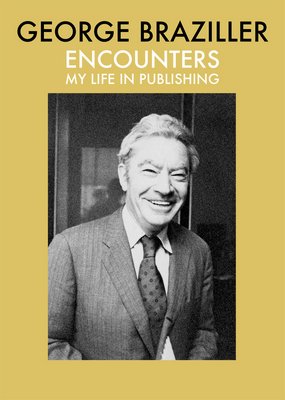
At the biblical age of 95, George Braziller retired from the publishing house that bears his name, and the problem he faced was that of so many retirees: what to do with his time.His family and friends encouraged him, “George, you have a wonderful story. Why not tell it?” And so tell it he has. Now 99, Mr. Braziller has published a memoir, “Encounters: My Life in Publishing” (George Braziller, 150 pp, $19.95, paperback).
“Encounters” is a series of vignettes, high points in his life and his career. There are dark moments, as when he refers obliquely to his often-troubled marriage with his wife, Marsha. But there are also lighter moments, as when Arthur Miller and Marilyn Monroe were his guests at his summer rental on Martha’s Vineyard. After a long evening of dancing, he told Marsha, “Gee, I kissed Marilyn.” “Big deal,” she replied. “Arthur kissed me.”
Though it is low-key and modest, it is really a remarkable book by a remarkable man. How many high-school dropouts create highly respected independent publishing houses and write memoirs at age 99?
Mr. Braziller, a frequent visitor to the East End, was born in Brooklyn in 1916, the youngest child of Yiddish-speaking Russian immigrants. His father died months before he was born and his mother had to support her family by selling used clothing from a pushcart. When he was 7, his mother remarried and they moved to Huntington Station.
When his stepfather died, they returned to Brooklyn. Mr. Braziller was 16. To help support the family, he left school and went to work for a traveling salesman, who sold “alpacuna” coats.
After an introduction to left-wing politics, Mr. Braziller joined the Young Communist League—not an unusual step at the time—and attended rallies in support of the Anti-Franco Republicans in Spain. This later prevented him from obtaining a passport, twice, even though he was a veteran and had fought in World War II in France.
His first venture into the publishing business was as a stock clerk in the Remainder Company, an overstock book firm. In 1941, he decided to start “The Book Find Club,” which was along the lines of America’s “Book of the Month Club” and Britain’s “Left Book Club.” It offered inexpensive books to the working class at prices they could afford.
When he left for the Army, the membership was 20,000. When he returned from the war, it had risen to 50,000 under Marsha’s leadership. In 1955, he founded his publishing company, George Braziller Inc., which is, 60 years later, still independent, yet to be swallowed up by the conglomerates.
Because Braziller is a small house, it could never offer large advances, so he went to Europe to find authors who were overlooked by the commercial houses. Thus he was the first publisher of Orhan Pamuk, the great Turkish novelist who ultimately won the Nobel Prize.
Other Nobel winners published by Mr. Braziller include Jean-Paul Sartre and Daniel Simon. Nathalie Sarraute, another French novelist published by him, was a significant figure in the movement called “le nouveau roman,” in which character, narrative and style are fragmented and distorted.
Through Simon and Sarraute, Mr. Braziller brought this major movement to the attention of American readers and critics. He also rescued the work of New Zealand novelist Janet Frame from the slush pile.
Mr. Braziller’s publishing house has always been noted for its beautiful art books, including the six-volume “Great American Artists Series,” featuring both representational painters and abstract expressionists. In a full-page review in the New York Times, Aline Saarinen wrote, “Bravo for Braziller! For the first time American artists have been treated with a respect and faith heretofore reserved for their French counterparts.”
Not that the French are neglected. Mr. Braziller also published Picasso and the American edition of Matisse’s extraordinary “Jazz,” which Matisse described as “the closest thing to an autobiography” he had ever created.
Mr. Braziller was also enchanted by an exhibition at the Morgan Library of the 15th-century devotional book, “The Hours of Catherine of Cleves.”
“Every exquisite page captured my attention,” he wrote. “A whole new world of art opened to me—the range of colors was dazzling and the details were astonishing, down to the tiniest leaves of the trees.” He published a reproduction, which was so popular it led to the publication of “some of the most important medieval manuscripts in history.”
Mr. Braziller has always chosen the beautiful, or significant, as opposed to the commercially appealing. He has elevated the business of publishing and created books that are themselves works of art. “Encounters” is a “summing up,” a fascinating and genuinely charming book by one of the giants of the golden age of publishing.